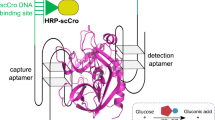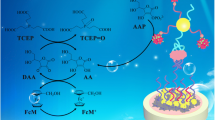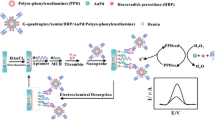Abstract
We propose a novel method to prepare a DNA–protein conjugate using histidine-tag (His-tag) chemistry. Oligo-DNA was modified with nitrilotriacetate (NTA), which has high affinity to a His-tag on recombinant protein via the complexation of Ni2+. Investigations using a microplate which displayed a complementary DNA-strand revealed that a NTA-modified DNA–protein conjugate was formed and immobilized in the presence of Ni2+ on the microplate. We then adopted alkaline phosphatase (AP) as a model protein, and application of the DNA–AP conjugate was demonstrated in a thrombin aptamer-based detection system with a detection limit of approximately 10 nM.
Similar content being viewed by others
Avoid common mistakes on your manuscript.
Introduction
A number of reports have demonstrated that both oligo-DNA and oligo-RNA are intelligent materials due to their highly-specific and designable binding properties with their complementary sequences. Some of them employ oligonucleotides as a sensing probe that can identify a target DNA or RNA strand (Tyagi and Kramer 1996; Maruyama et al. 2007). Other researchers have used oligonucleotides as a building block to construct nanostructured systems with a well-designed geometry as well as to prepare the DNA-programmed assembly of colloids, proteins and cells into a spatially designed arrangement (Seeman 2003; Yan et al. 2003; Beissenhirtz and Willner 2006). Due to the accurate and robust hybridization ability of the oligonucleotide, the conjugation of an oligonucleotide with a protein produces a new class of functionalized biomolecules that exhibits both the properties of an oligonucleotide and a protein. To date, several research groups have studied DNA–protein conjugates and have demonstrated their high potential and multi-functionality as molecular devices (Saghatelian et al. 2003; Boozer et al. 2004). For instance, the conjugates can be immobilized onto a surface displaying the complementary DNA (cDNA) via DNA hybridization, resulting in the oriented protein-immobilization. To date, chemical modifications using bifunctional linkers has been widely used to covalently cross-link DNA and protein (Niemeyer 2001, 2002). Recently, the site-specific syntheses of DNA–protein conjugates have been reported using expressed protein ligation (EPL) (Takeda et al. 2004) and by transglutaminase (Tominaga et al. 2007) to prevent inactivation and heterogeneous modification of proteins.
Here we propose a novel and simple strategy for site-specific DNA–protein conjugation using His-tag chemistry. The His-tag (hexahistidine-tag) is one of the widely-used peptidyl tags in recombinant protein production and popularly used in affinity purification of recombinant proteins via the complexation of Ni2+–nitrilotriacetic acid (NTA) (Schmitt et al. 1993). The application of the His-tag strategy allows us to readily prepare a wide variety of DNA–protein conjugates. In the present study, we investigated the conjugation of a His-tagged enzyme to a newly prepared NTA-modified DNA, and its application to oriented immobilization through DNA hybridization. Furthermore, we applied this DNA–enzyme conjugation for an aptamer-based detection system, where the binding between the DNA-aptamer and a target molecule (thrombin) can be determined from the enzyme activity.
Materials and methods
Materials
Maleimido-C3-NTA (N-[5-(3′-maleimidopropylamido)-1-carboxypentyl]iminodiacetic acid, disodium salt, monohydrate) was purchased from Dojindo (Kumamoto, Japan). Thiol- or biotin-modified DNA oligonucleotides were purchased from Tsukuba Oligo Service Co. Ltd. (Tsukuba, Japan). Thrombin from bovine plasma was purchased from Sigma-Aldrich (St. Louis, MO). Bovine serum albumin (BSA) was purchased from Wako Pure Chemicals Industries Ltd. (Osaka, Japan). The plasmid pET20-AP encoding E. coli alkaline phosphatase (AP) gene was kindly provided by Prof. Hiroshi Ueda from the University of Tokyo. Nunc immobilizer-streptavidin plates were purchased from Nalge Nunc International Co. Ltd. (Tokyo). The ECF substrate solution was purchased from GE Healthcare UK Ltd. (Little Chalfont, UK). Immobilized TCEP Disulfide Reducing Gel slurry was purchased from Pierce Biotechnology (Rockville, IL).
Preparation of His-tagged alkaline phosphatase
His-tagged alkaline phosphatase (His-AP) was designed by genetically introducing hexahistidine residues to the C-terminus of AP. A DNA fragment encoding AP was amplified by the polymerase chain reaction (PCR) using pET20-AP as the template DNA. The primer nucleotide sequences used for the PCR were 5′-GGC GGG GAT CCG ACC CCA GAA ATG CCT GTT CTA G-3′ and 5′-CCC CAA GCT TCT CGA GTT TCA GCC CCA GAG CGG CTT TCA TGG-3′. The resultant gene fragment encoding AP with BamHI and XhoI sites was cloned into a bacterial expression plasmid vector, pET22b(+) (Novagen). His-AP was expressed in the E. coli strain BL21. The His-APwas purified from the crude extract using a Ni-chelating affinity column and desalted to give a single band on SDS-PAGE.
Preparation of NTA-modified DNA
Thiol-modified DNA oligonucleotides (1 mM) in HEPES buffer (100 mM, pH 7.5) were mixed and activated with 2-fold amounts of immobilized TCEP disulfide reducing gel slurry for 2 h at room temperature. Maleimido–C3–NTA (0.5 mg/ml) was mixed with the activated thiol-modified DNA solution and incubated at room temperature for 20 h. NTA-modified DNA was purified by HPLC using an ODS column and the product was identified by MALDI-TOF-MS.
Formation of a DNA–AP conjugate via Ni-chelating on a microplate
The following DNA oligonucleotide sequences were used for DNA-directed immobilization of a DNA–AP conjugate by Ni2+ complexation and by DNA hybridization. They were thiol-modified DNA (5′-CCC AGG TCA GTG-(CH2)3-SH-3′) and biotinylated cDNA (5′-CAC TGA CCT GGG-(CH2)6-biotin-3′). All chemicals were diluted with Tris Buffered Saline (TBS; 25 mM Tris/HCl, 137 mM NaCl, 2.68 mM KCl, pH 7.4). The washing buffer solution (TBST) was prepared from TBS containing Tween 20 (0.05% v/v). All the experiments were carried out at room temperature.
Biotinylated cDNA (200 nM, 100 μl), which was complementary to the NTA-modified DNA, was added to wells of a streptavidin-coated 96-well microplate and incubated for 1 h. After the wells were rinsed with TBST, and NTA-modified DNA (200 nM, 100 μl) was added to the wells. After incubation for 1 h, the wells were rinsed with TBST. Nickel chelation was performed by spotting TBS containing NiCl2 (200 nM, 100 μl). After incubation for 30 min, the wells were rinsed with TBST and then His-AP solution (1 nM, 100 μl) was added to wells. After rinsing the wells with TBST, AP substrate (ECF, 100-fold dilution by Tris–HCl (1 M, pH 8.0, 150 μl) was added to the wells. Two hours later, the fluorescent intensity was measured using a fluorescent imager (Molecular imager FxPro, Bio-Rad) to confirm the conjugation of His-AP with NTA-modified DNA.
Application for an aptamer-based detection system
For the purposes of the application of the aptamer-based detection system, two kinds of DNA oligonucleotides were used. One was a NTA-modified DNA whose sequence was NTA-5′-(CH2)6-GCT CTC CAA CCA-3′ and another was a 35-mer biotinylated cDNA aptamer whose sequence was biotin-5′-(CH2)6-TTT TTT TTT TTT TTT GGT TGG TG T GGT TGG AGA GC-3′. The underlined sequence was the thrombin-binding aptamer and the italic sequence was the hybridization sequence to NTA-modified DNA.
NTA-modified DNA was mixed with an equimolar amount of Ni2+ in MOPS buffer (100 mM, pH 7.9) to prepare Ni2+-charged NTA-modified DNA (Ni–NTA-modified DNA). 5′-Biotinylated cDNA aptamer (200 nM, 100 μl) was added to wells of a streptavidin-coated 96-well microplate. After incubation for 1 h, the wells were rinsed with TBST and Ni–NTA-modified DNA (200 nM, 100 μl) was added to the wells displaying cDNA aptamer for 1 h. Then after rinsing the wells with TBST, thrombin solution at varying concentrations or BSA solution (500 nM) was added to the wells. After rinsing the wells with TBST, His-AP (1 nM, 100 μl) was also added to wells. After incubation for 1 h and rinsing the wells with TBST, AP substrate (ECF, 100-fold dilution by Tris–HCl (1 M, pH8.0), 150 μl) was added to the wells. Two hours later, the fluorescent intensity was measured using a fluorescent imager to quantitate His-AP on a microplate.
Results and discussion
Formation of the DNA–AP conjugate using His-tag chemistry
Protein purification using a His-tag employs an immobilized octahedral metal-chelated complex, like Ni–nitrilotriacetic acid (NTA). The chelator NTA occupies four sites in the metal coordination sphere of a nickel ion. The remaining two free sites in the octahedral coordination sphere are available for selective protein interactions. The binding of a hexahistidine-tag in a protein to the Ni–NTA has been widely used due to high binding specificity, reasonable affinity and oriented attachment on a solid surface without denaturation, while having the added benefit that it is fully reversible by the addition of a competitive ligand or removal of the nickel ion (Schmid et al. 1997; Hainfeld et al. 1999).
Here we adopt this His-tag chemistry to prepare a DNA–protein conjugate. First, a hexahistidine-tag was genetically attached to the C-terminus of alkaline phosphatase (His-AP). Next the chelator NTA was covalently bound to a thiol group at the terminus of the DNA oligonucleotide, and the resulting product was designated a NTA-modified DNA.
To confirm the successful conjugation of the His-AP and NTA-modified DNA via Ni2+ complexation, we investigated the immobilization of the DNA–AP conjugate on a microplate displaying cDNA (complementary to the NTA-modified DNA) (Fig. 1a). The immobilization of the DNA–AP conjugate on the microplate was monitored by the AP-catalyzed reaction using a fluorescent substrate. Figure 1b shows the fluorescent intensity derived from the His-AP activity on the microplate. Lane 1 (in the presence of His-AP, NTA-modified DNA and Ni2+) shows about 7-fold higher Δfluorescent intensity compared to the other lanes, meaning the immobilization of His-AP on a cDNA-displaying microplate was successful. As negative controls for the experiments of the DNA–AP conjugation, the absence of Ni2+ (lane 2), NTA-modified DNA (lane 3) or biotinylated cDNA (lane 4) resulted in a negligible increase in fluorescent intensity, meaning a small amount of DNA–AP immobilization on the microplate occurred. These results suggest a conjugation of DNA and His-AP via the complexation of Ni2+ and also the immobilization of the DNA–AP conjugate on the microplate by preserving AP activity.
(a) Schematic illustration of the conjugation of NTA-modified DNA with His-AP via the complexation of Ni2+ on a microplate displaying cDNA. (b) Fluorescent intensity change induced by the His-AP catalyzed reaction using the fluorescent substrate (ECF). His-AP (1 nM, 100 μl) was immobilized on a cDNA-displaying microplate via NTA-modified DNA in the presence of Ni2+ (lane 1). As controls, His-AP was also applied in the absence of Ni2+ (200 nM, 100 μl) (lane 2), in the absence of NTA-modified DNA (200 nM, 100 μl) (lane 3), and in the absence of biotinylated cDNA displaying microplate (200 nM, 100 μl) (lane 4). The fluorescent image of each lane was also shown. The fluorescent intensity changes are given as averages of three experiments, and error bars represent the standard deviations
Application to the aptamer-based detection system
There are several noteworthy reports that describe the high potential of DNA–enzyme conjugates in the analytical field (Drolet et al. 1996). Some of them exemplified the amplification of molecular signals by enzymes to read out the molecular events of DNA. We therefore applied this DNA–AP conjugation to read out an interaction of DNA with a certain molecule. Nucleic-acid aptamers, which are single-stranded oligonucleotides, have been attractive as an analytical tool because they can bind to a broad range of target molecules with high affinity and specificity (Ellington and Szostak 1990; Tuerk and Gold 1990; Nutiu and Li 2003). We attempted to develop a novel aptamer-based detection system using the DNA–AP conjugate.
We used a 5′-biotinylated cDNA aptamer, which was composed of a 15-mer poly(dT) spacer-strand, a 15-mer thrombin-binding aptamer (Bock et al. 1992) and a 5-mer sticky-end. The strategy to detect thrombin using the DNA–AP conjugate is illustrated in Fig. 2. The biotinylated cDNA aptamer was first immobilized on a streptavidin-coated 96-well microplate. The Ni2+–NTA-modified DNA was added to hybridize with the sticky-end of the biotinylated cDNA aptamer. An analyte solution containing thrombin was added to a well to induce the binding of the aptamer sequence with thrombin. In the presence of thrombin, the biotinylated cDNA aptamer was occupied by thrombin and the Ni2+–NTA-modified DNA was released from the biotinylated cDNA aptamer. As a result, His-AP was unable to be immobilized on the microplate, resulting in no or little AP activity. On the other hand, the absence of thrombin allowed the immobilization of His-AP onto the microplate via Ni2+–NTA-modified DNA, resulting in remarkable AP activity. Therefore, the presence of the target (thrombin) could be determined by measuring the immobilized AP activity.
Schematic illustration of the aptamer-based thrombin detection system using the DNA–AP conjugate. (a) In the absence of an aptamer-substrate (thrombin), the aptamer was hybridized with NTA-modified DNA, and His-AP was immobilized via complexation of Ni2+. (b) In the presence of thrombin, the aptamer was transformed into a thrombin-aptamer complex to prevent DNA hybridization between the aptamer and NTA-modified DNA, resulting in non-immobilization of His-AP on a microplate
Figure 3 shows the effect of the thrombin concentration on the change in fluorescent intensity derived from immobilized His-AP. As the thrombin concentration increased above 10 nM, the fluorescent intensity obviously decreased. These results indicate the decrease in the immobilized DNA–AP conjugate with the increase in the thrombin concentration. In other words, the concentration of thrombin in an analyte solution can be quantitatively and visually read out by the enzymatic activity of the DNA–AP conjugate. The detection limit of the present system was approximately 10 nM.
Effect of the thrombin concentration on the fluorescent intensity derived from the immobilized His-AP. First, Ni2+-charged NTA-modified DNA was hybridized with 5′-biotinylated cDNA aptamer immobilized on a streptavidin-coated plate. Then, thrombin solution at varying concentration (1 nM ~ 6 μM) was added to the wells. After washing the wells, His-AP was added to gain the fluorescent signal. The fluorescent intensity changes are given as averages of three experiments, and error bars represent the standard deviations
Finally we also used BSA as a non-binding protein to study the detection specificity of the present aptamer-based detection system. Thrombin and BSA at the same concentrations (500 nM) were applied. Figure 4 shows the fluorescence changes induced by BSA or thrombin. While thrombin caused about 90% decrease in the fluorescent intensity, BSA resulted in only 20% decrease in the signal. These results support our hypothesis illustrated in Fig. 2, where AP activity reports the specific binding between thrombin and thrombin binding aptamer.
Specificity of protein detection in the present aptamer-based detection system. ΔFluorescent intensity represents the fluorescence change derived from the immobilized His-AP. Lane 1 was without any protein, lane 2 was BSA (500 nM) and lane 3 was thrombin (500 nM). The fluorescent image of each lane was also shown. The fluorescent intensity changes are given as averages of three experiments, and error bars represent the standard deviations
In conclusion, we have prepared a wide variety of DNA-protein (enzyme) conjugates using a His-tag on a microplate. We then applied the DNA-enzyme conjugate to thrombin detection using a thrombin-binding DNA aptamer. The DNA-enzyme conjugate reads out the binding of the DNA aptamer to thrombin as the enzyme activity. The thrombin concentrations in analytes could then be determined by simply measuring the enzyme activity. This strategy will therefore be useful and versatile for protein immobilization and preparation of multifunctional biomolecules.
References
Beissenhirtz MK, Willner I (2006) DNA-based machines. Org Biomol Chem 4:3392–3401
Bock LC, Griffin LC, Latham JA, Vermaas EH, Toole JJ (1992) Selection of single-stranded DNA molecules that bind and inhibit human thrombin. Nature 355:564–566
Boozer C, Ladd J, Chen S, Yu Q, Homola J, Jiang S (2004) DNA directed protein immobilization on mixed ssDNA/oligo(ethylene glycol) self-assembled monolayers for sensitive biosensor. Anal Chem 76:6967–6972
Drolet DW, MoonMcDermott L, Romig TS (1996) An enzyme-linked oligonucleotide assay. Nat Biotechnol 14:1021–1025
Ellington AD, Szostak JW (1990) In vitro selection of RNA molecules that bind specific ligands. Nature 346:818–822
Hainfeld JF, Liu WQ, Halsey CMR, Freimuth P, Powell RD (1999) Ni–NTA–gold clusters target his-tagged proteins. J Struct Biol 127:185–198
Maruyama T, Hosogi T, Goto M (2007) Sequence-selective extraction of single-strand DNA using DNA-functionalized reverse micelles. Chem Commun 43:4450–4452
Niemeyer CM (2001) Bioorganic applications of semisynthetic DNA–protein conjugates. Chem Eur J 7:3189–3195
Niemeyer CM (2002) The developments of semisynthetic DNA–protein conjugates. Trends Biotechnol 20:395–401
Nutiu R, Li YF (2003) Structure-switching signaling aptamers. J Am Chem Soc 125:4771–4778
Saghatelian A, Guckian KM, Thayer DA, Ghadiri MR (2003) DNA detection and signal amplification via an engineered allosteric enzyme. J Am Chem Soc 125:344–345
Schmid EL, Keller TA, Dienes Z, Vogel H (1997) Reversible oriented surface immobilization of functional proteins on oxide surfaces. Anal Chem 69:1979–1985
Schmitt J, Hess H, Stunnenberg HG (1993) Affinity purification of histidine-tagged proteins. Mol Biol Rep 18:223–230
Seeman NC (2003) DNA in a material world. Nature 421:427–431
Takeda S, Tsukiji S, Nagamune T (2004) Site-specific conjugation of oligonucleotides to the C-terminus of recombinant protein by expressed protein ligation. Bioorg Med Chem Lett 14:2407–2410
Tominaga J, Kemori Y, Tanaka Y, Maruyama T, Kamiya N, Goto M (2007) An enzymatic method for site-specific labeling of recombinant proteins with oligonucleotides. Chem Commun 4:401–403
Tuerk C, Gold L (1990) Systematic evolution of ligands by exponential enrichment—RNA ligands to bacteriophage-T4 DNA-polymerase. Science 249:505–510
Tyagi S, Kramer FR (1996) Molecular beacons: probes that fluorescence upon hybridization. Nat Biotechnol 14:303–308
Yan H, Park SH, Finkelstein G, Reif JH, LaBean TH (2003) DNA-templated self-assembly of protein arrays and highly conductive nanowires. Science 301:1882–1884
Acknowledgements
The present work is supported by a Grant-in-Aid for the Global COE Program, “Science for Future Molecular Systems” from the Ministry of Education, Culture, Sports, Science and Technology of Japan.
Author information
Authors and Affiliations
Corresponding authors
Rights and permissions
About this article
Cite this article
Shimada, J., Maruyama, T., Hosogi, T. et al. Conjugation of DNA with protein using His-tag chemistry and its application to the aptamer-based detection system. Biotechnol Lett 30, 2001–2006 (2008). https://doi.org/10.1007/s10529-008-9784-4
Received:
Revised:
Accepted:
Published:
Issue Date:
DOI: https://doi.org/10.1007/s10529-008-9784-4








